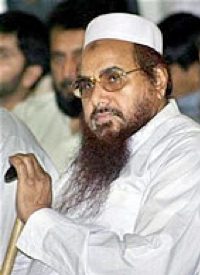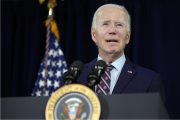
Ten million dollars is nearly the highest reward offered by the State Department for a suspected terrorist. In fact, the sum awarded for Saeed is second only to that offered for Ayman al-Zawahri, the man believed to have taken over control of al-Qaeda following the killing of Osama bin Laden last May. Al-Zawahri’s bounty is set at $25 million.
The placing of a reward on Saeed is seen as yet another move by the American government that will place further strain on the already tense relationship with Pakistan, the U.S.‘s erstwhile ally in the “War on Terror.”
Major news outlets reporting on the State Department’s announcement of the bounty on Saeed chronicle the Pakistani native’s criminal background. Most accounts, for example, are similar to this one published by USA Today:
Hafiz Saeed founded Lashkar-e-Taiba in the 1980s, allegedly with Pakistani support to pressure archenemy India over the disputed territory of Kashmir. Pakistan banned the group in 2002 under pressure from the U.S. but has done little to crack down on its activities.
Saeed operates openly in the country, giving public speeches and appearing on TV talk shows. The U.S. also offered up to $2 million for Lashkar-e-Taiba's deputy leader, Hafiz Abdul Rahman Makki.
Curiously, the USA Today article cites a story published by the Times of India wherein a United States Undersecretary of State, Wendy Sherman, is reported to have “announced the bounty for [Saeed] … on Monday during a visit to India….”
In the article, Saeed is identified as the chief of the Lashkar-e-Taiba, a Pakistani “militant group.” This appellation was challenged in another article published in India following the American special operations mission in Abbottabad, Pakistan that ended with the death of Osama bin Laden.
The piece paints a perplexing and painful picture of a somewhat sinister relationship between Saeed and Lashkar-e-Taiba and the American intelligence agency, the CIA.
While the information in India Today was compelling, there is a more particular and well-documented description of the history of the “militant” group, its alleged founder, and the intelligence apparatus of the United States.
These include Michel Chossudovsky’s report, 9/11 ANALYSIS: From Ronald Reagan and the Soviet-Afghan War to George W Bush and September 11, 2001, and the story of the origins of Lashkar-e-Taiba, as well as other supposed Islamic fundamentalists using terror to threaten the security of the American homeland. The following account is taken from Mr. Chossudovsky’s eye-opening analysis of the birth of al-Qaeda specifically, and Islamic terrorism, in general.
The account related in that report draws lines connecting Hizbul Mujahedeen (and several other supposed al-Qaeda affiliates) to the CIA. From the report:
These various "terrorist" organizations were created as a result of CIA support. They are not the product of religion. The project to establish "a pan-Islamic Caliphate" is part of a carefully devised intelligence operation.
CIA support to Al Qaeda was not in any way curtailed at the end of the Cold War. In fact quite the opposite. The earlier pattern of covert support took on a global thrust and became increasingly sophisticated.
The "Global War on Terrorism" is a complex and intricate intelligence construct. The covert support provided to "Islamic extremist groups" is part of an imperial agenda. It purports to weaken and eventually destroy secular and civilian governmental institutions, while also contributing to vilifying Islam. It is an instrument of colonization which seeks to undermine sovereign nation-states and transform countries into territories.
For the intelligence operation to be successful, however, the various Islamic organizations created and trained by the CIA must remain unaware of the role they are performing on the geopolitical chessboard, on behalf of Washington.
And:
The various fundamentalist and paramilitary groups involved in US sponsored "terrorist" activities are "intelligence assets". In the wake of 9/11, their designated function as "intelligence assets" is to perform their role as credible "enemies of America."
Under the Bush administration, the CIA continued to support (via Pakistan's ISI) several Pakistani based Islamic groups. The ISI is known to support Jamaat a-Islami, which is also present in South East Asia, Lashkar-e-Tayyaba, Jehad a-Kashmiri, Hizbul-Mujahidin and Jaish-e-Mohammed.
Notice the inclusion of Saeed’s Lashkar-e-Taiba (albeit with an alternate spelling) in the list of those Pakistani-based “terrorist organizations” that received their training and tools through funds provided to the Pakistani intelligence service by the Central Intelligence Agency. Is the purpose of CIA’s creation of this complex coterie of “Islamic fundamentalists”-cum-terrorists truly, as Chussudovsky asserts, part of an American “imperial agenda” designed to “weaken and eventually destroy secular and civilian governmental institutions, while also contributing to vilifying Islam.”? Is it genuinely an “instrument of colonization which seeks to undermine sovereign nation-states and transform countries into territories”?
These questions are to be answered by those willing to read, investigate, and climb along the manifold twisted and gnarled branches of the family tree of global terrorism. One is hopeful that the roots of this tree do not grow deeply into the once fertile and free soil of the American republic.
Naturally, the official response to Chossudovsky’s claims is that there has never been any collusion between Pakistan, the Inter Services Intelligence, and terrorists. Statements issued from Islamabad and Washington are faithful to the party line that Pakistan is a committed ally in the “Global War on Terror” and has handed over all relevant information to the Americans since 2009.
That said, Pakistan’s willingness to cooperate with the United States’ campaign to capture suspected terrorists thought to be living in that nation may be waning. The decline is primarily a result of the death by American Predator drone of 24 Pakistani soldiers deployed along that nation’s border with Afghanistan.
Pakistan retaliated for the deaths by shutting down the pipeline of NATO materiel that runs through the country, as well as booting the United States and its Predator drones off an airbase in the southwest region of the country. The American military commanders must now prepare for the planned withdrawal of forces from Afghanistan by constructing an alternate route through Central Asia. The cost of the re-routing is considered significant enough for the United States to begin a dialogue with Pakistani officials.
The move proved to be little more than an inconvenience, as the base was used by the United States only to repair planes and Predators damaged in Afghanistan. For Pakistan, though, the opposition is likely indicative of a more long-term policy shift. In fact, the nation’s parliament is now embroiled in lengthy debates about their support for the drone program going forward.
On Thursday, officials of the government of Pakistan called for talks with the United States to commence before the debates in parliament are wrapped up.
Earlier last week, President Obama and Pakistan's Prime Minister Yousuf Raza Gilani met at a nuclear summit in Seoul and reportedly "made important progress" in resolving the concerns of both sides regarding the continuing alliance in the tracking, targeting, and eliminating of those accused by the United States of being members of the Taliban or al-Qaeda. The next day, American military commanders of the now decade-long conflict in Afghanistan met with colleagues from the Pakistani armed forces to discuss the deaths of the Pakistani soldiers last November. Pakistan demands an apology, but the United States has as yet demurred, insisting that the strike targeting the Pakistani soldiers was an accident.
For his part, Hafiz Muhammad Saeed maintains that he is the head of Jama'at-ud-Da'wah, a charity organization that, in spite of claims to the contrary made by the government of the United States, is in no way associated with Lashkar-e-Taiba.


